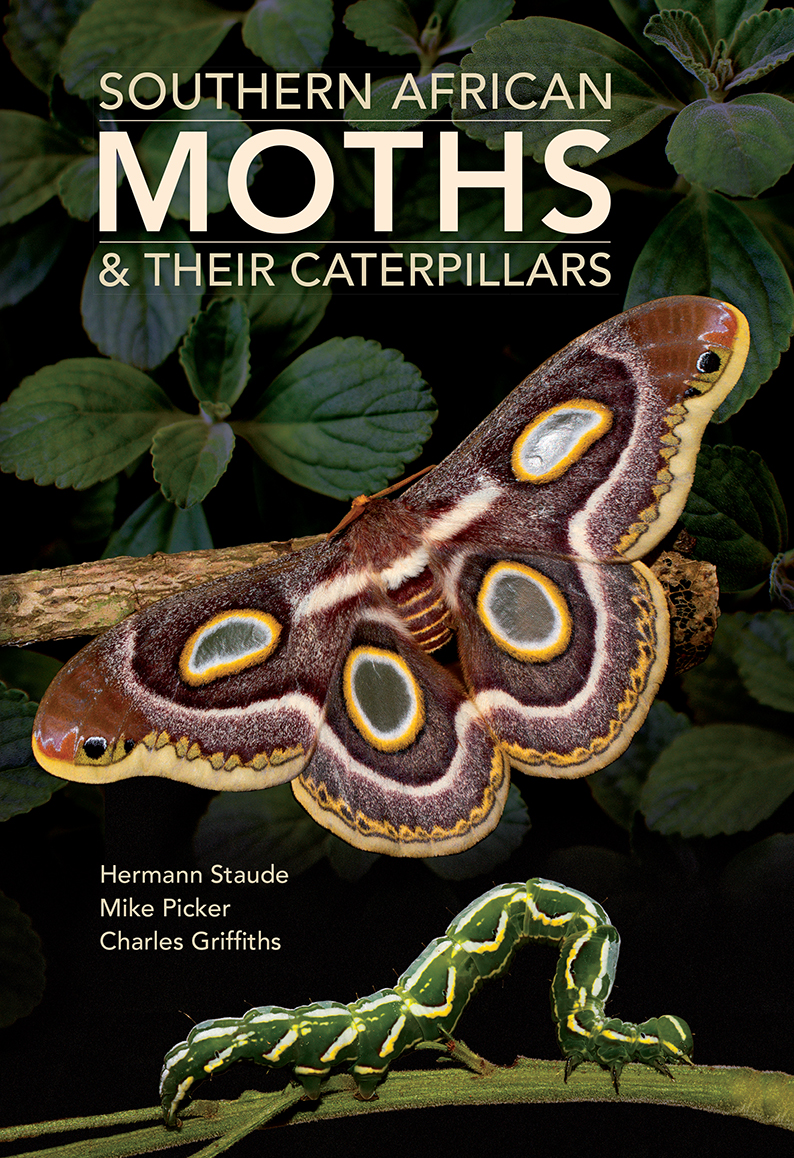Biological recording & species identification Lepidoptera Publications
Hermann Staude, Mike Picker and Charles Griffiths
Struik Nature/Penguin Random House South Africa; Pelagic Publishing (UK)
2023
ISBN: 978177584795 (South Africa); 99781784273477 (UK)
Reviewed by Henk Geertsema
In the past few decades many paperbacks, each presenting a selected overview of southern African flora and fauna , have appeared. Many popular guides dealing with butterflies are available, but the need for a similar informative source on moths was clear. This has now been addressed with the publication of Southern African Moths & their Caterpillars.
Its congener, Insects of South Africa, now in its third print, by Mike Picker, Charles Griffiths and Alan Weaving, has introduced the general public to our great insect diversity. In Southern African Moths & their Caterpillars Hermann Staude, our leading expert on southern African moths, has teamed up with Mike Picker and Charles Griffiths. Many photographs have been supplied by members of the Caterpillar Rearing Group, a division of the Lepidopterists’ Society of Africa. The described moth species of southern Africa has increased from the 3,607 in A.J.T. Janse’s (1917) Checklist to more than 11,000, with further discoveries and descriptions of new species being added on a regular basis. In this book, a sample of 1,500 species represents a well-balanced overview of moth species, thus serving as a very useful introductory guide to this vast group of insects.
The Contents lists moth families in an evolutionary sequence. An extensive Acknowledgements lists the contributions made by many individuals to this book. The Preface refers to some modern overviews of specific groups of moths and ends with the prime aim of the present work: to provide a rather comprehensive introduction to the moth fauna of southern Africa.
The Introduction features a short cladogram showing the evolutionary development of the Lepidoptera and includes a discussion of the earliest moths and their long-time association with plants. In Diversity of moths, the southern African moths are said to comprise about 11,000 described species, surpassing by far the mere 800 butterfly species known in this region. Wing features discusses size and shape, colour patterns and some special features of wings, and comments on body hair and scales. Life cycle briefly outlines the development from egg to caterpillar to adult but, unfortunately, the authors fail to discuss the pupal stage or the presence of a cocoon, a characteristic feature of many moths. Mating describes their mating behaviour and time of flight. Egg laying and the egg phase outlines the mode of oviposition, number of eggs and hatching periods. The caterpillar (larval) phase discusses hatching , body shape, feeding preferences and duration. The adult phase describes feeding or non-feeding of moths. Adult emergence and seasonality relates seasonal and geographical appearance of moths to rainfall and other environmental conditions. Defence adaptations discusses methods of defence against natural enemies. In caterpillars, defence mechanisms include concealment amongst foliage, day-time inactivity, living underground or within plant material. Physical and chemical deterrents are frequent. Some caterpillars live in communal sheltered structures or in groups to avoid predation. Most moths are masters at camouflage, mimicking leaves, bark, broken twigs, wasps or even bird droppings. Many contain toxins, deterring natural enemies. Some moths, in response to bat predation, have evolved evasive flight patterns or sound emission in response to bat sonar. Some feign death after disturbance or attack. Regional distributional patterns indicates that some species range over extensive or restricted geographical regions, usually in response to availability of food Ecological importance deals with the effect of mass feeding by caterpillars on natural vegetation. Sometimes, in the absence of their natural enemies, major defoliation by caterpillars of specific trees or crops takes place, often needing the application of insecticides with adverse effects on ecosystems. In Conservation status the Lepidopterists’ Society of Africa, supported by the South African National Biodiversity Institute (SANBI), based on observations made by their members, aims to determine the conservation status of southern African lepidopteran species. Determination of the conservation status of individual moths, based on 262,000 submitted records, is evaluated.
Readers are invited to get involved in the conservation by joining the Lepidopterists Society of Africa and its specialist Caterpillar Rearing Group project (https://lepsocafrica.org). The Society has an international membership and includes professional as well as amateur lepidopterists.
About this book explains the arrangement of the guide, giving for each individual species, scientific detail and features of family, subfamily, genus, species and vernacular names, a brief description of each adult moth, some biological facts relating to the caterpillar and its foodplant, habitat and a map featuring the known distribution in southern Africa. All photographs are of high quality, in full colour and show adult moths or caterpillars in their natural poses. All caterpillars pictured are near or fully-grown. What is missing is an indication of the size of the caterpillar.
The book concludes with a List of photographers, a brief Further reading of some recent relevant publications and websites, an alphabetic Index to scientific names and an Index to common names.
This book is intended for all interested in the biodiversity of our wonderful wildlife and forms an excellent introduction to our diverse and extensive moth fauna; to the moth specialist this book is a must. It fulfils a need for an information source on southern African moths and every natural history educational centre should have a copy. In my opinion, at its weight, it is not a field guide but rather an introductory reference to be consulted at leisure. Photographer are invited to submit their photos for an expert opinion. This informative and long-awaited guide iswell-worth its price tag. In time this book will surely be reprinted and revised, hopefully in a larger format. As only a mere 15% of moth species are dealt with at present, it is hoped that more volumes are to follow.


